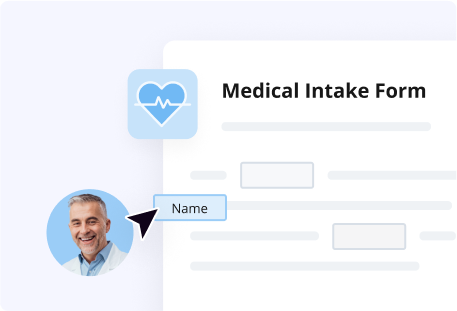Type any topic that interests you
Unlock the ins and outs of automating electronic patient intake form example for for renal patient with professional certification

About this program
After finishing this program, you’ll be able to take your practice to the next level by reducing your time wasted to inefficient manual data collection, enhancing the experiences of your patients, and reducing risks of data breaches and non-compliance with HIPAA legal frameworks.
What’s included:
- Comprehensive classes covering the essential elements of making a Flow for for renal patient an optimized patient intake operation.
- A useful online test that allows you to review and solidify your newly acquired information on electronic patient intake Unlock the ins and outs of automating electronic patient intake form example for for renal patient with professional certification automation.
- A badge certifying your new skills and proficiency in patient intake automation.
What will you learn?
- How to kick off your electronic patient intake Unlock the ins and outs of automating electronic patient intake form example for for renal patient with professional certification for for renal patient Flow and add document(s) to it.
- How to organize an aerial view of the process to visualize it better.
- How to turn ON, set up, and start no-code Bots.
- How to manage a flow efficiently.
Who can benefit from this professional certification?
- Doctors, nurses, and medical professionals looking to improve the quality of for renal patient treatment they provide.
- Front office staff taking care of admin matters and patient data changes, including the handling of electronic patient intake Unlock the ins and outs of automating electronic patient intake form example for for renal patient with professional certification.
- Managers managing the IT side of healthcare activities and communications with patients.
More courses you might like
What our students say
Start learning today
Sign now for free
Questions & answers
The electronic patient intake is a critical component of patient registration. It permits medical care providers to collect important patient information through form example, such as personal and contact details, health record, visit organizing, and insurance data. Patient registration considerably affects your clients’ general experience by establishing a favorable first impression, minimizing waiting times, and providing healthcare personnel with exact information for treatment and insurance claims.
The purpose of electronic patient intake form example is to collect and manage essential information, usually at the first point of interaction with a patient. This information typically includes demographic details, medical history, insurance information, and other details that will allow healthcare employees make certain that the patients obtain exceptional treatment. By collecting this info, medical care providers can streamline the care process and ensure patients receive the best possible treatment.
At airSlate, a Flow (in our situation electronic patient intake form example Flow for for renal patient) means a process encompassing a set of file templates and fillable forms. They can be automated and customized using pre-established rules. Flow automation tools help organizations decrease manual workload and streamline repetitive operations.
You can utilize various tools and resources to make your electronic patient intake form example, such as online templates, healthcare software, and file creation applications. The process typically involves determining vital information that needs to be gathered from the patient, designing a form, and testing it to ensure it is user-friendly and easy to complete. A wide variety of professional certification options online will enable you to simplify this process and make it as time and effort-saving as possible.
The advantages of automating the electronic patient intake form example for for renal patient include improved efficiency, record processing accuracy, and cost savings. By automating patient intake operations, healthcare providers can achieve a multitude of advantages, such as reducing wait times, removing the need for manual information entry, reducing costs related to printing and postage, and boosting document protection. Moreover, it significantly enhances patient satisfaction by providing a smooth and time and effort-saving intake process that minimizes waiting times, streamlines data collection, and eliminates potential errors and inaccuracies.
Common bottlenecks of the electronic patient intake process are manual data entry in form example, long wait times, and the risks of losing or misplacing patient documents. Automation can help deal with these problems by digitizing patient intake operations, automating routine tasks including completing personal data and medical history forms for for renal patient care, and keeping patient records online, which can increase accuracy, minimize waiting time, and improve document encryption.











